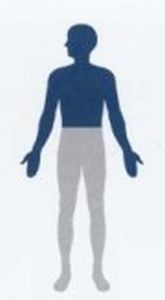

MedFriendly®


Paraplegia
Paraplegia is a loss of the ability to move and/or feel both legs and
generally, the lower trunk (stomach area and lower back). This is
depicted in the picture to the right in which the person cannot move
and/or feel the area in gray.
WHAT CAUSES PARAPLEGIA?
Paraplegia is often caused by an injury to the spinal cord, such as
those resulting from a motor vehicle or motorcycle accident, gunshot
wounds, and falls. Paraplegia can also be caused by non-traumatic
factors such as spinal tumors, scoliosis, and spina bifida. Scoliosis is
an abnormal sideways curving of the bones that make up the structure
surrounding the spinal cord. Spina bifida is a birth defect in which parts
of bones that make up the structure surrounding the spinal cord do not
come together properly.
FEATURED BOOK: Spinal Cord Injury: Functional Rehabilitation
WHAT ARE SOME COMMON CHARACTERISTICS OF PARAPLEGIA?
Immediately after the spinal cord injury, the loss of movement, sensation, and reflexes
below the level of the spinal cord injury can occur. Sexual dysfunction and loss of bowel
and bladder control may also occur, depending on where the spinal cord injury occurred
and if the spinal cord was completely cut or partially cut.
WHAT IS THE DIFFERENCE IN FUNCTIONING BETWEEN SOMEONE WITH A
COMPLETELY CUT SPINAL CORD VERSUS A PARTIALLY CUT SPINAL CORD?
As you may have guessed, it is worse to have the spinal cord completely cut than
partially cut. When the spinal cord is completely cut, movement and sensation is no
longer present below the level of the spinal cord injury. When the spinal cord is partially
cut, there is some movement and sensation present below the level of the spinal cord
injury. In partial spinal cord cuts, control of the sphincters is usually intact, as is the
ability to voluntarily flex the toes and to have sensation in the anal area. A sphincter is a
muscle that forms a circle around a natural passageway in the body. For example, the
"Where Medical Information is Easy to Understand"™
HOW MANY PEOPLE HAVE PARAPLEGIA?
Each year, approximately 11,000 people have spinal cord injuries
that result in paraplegia.
WHAT AGE ARE MOST PEOPLE WITH PARAPLEGIA?
Since 2000, the average age of people with a spinal cord injury
ranges from about 31 to 40. However, spinal cord injury can occur
at any age.
HOW IS PARAPLEGIA TREATED?


The way paraplegia is initially treated at the scene of the injury is to prevent any further and possibly
permanent injury to the spine by strapping the person to a special type of board. Any pressure on the
spine or the brain needs to be removed. Regaining the proper shape of the spine through surgery is
another goal of treatment, with the affected person entering a rehabilitation program as soon as possible.
Medications to prevent muscle spasms caused by dysfunction to upper motor neurons (types of nerve
cells important for movement) may also be used. To provide support to the abdomen (belly) area due to
weak muscles, a bandage known as an abdomen binder is wrapped around it.
Unfortunately, there is no specific treatment at this time to reverse paraplegia. Instead, treatment is
aimed at problems associated with paraplegia, such as blood clots and constipation. To prevent blood
clots, the patient is given special stockings to wear on the legs. A blood clot is a thick mass of blood.
Tight bandages on the belly (known as abdominal binders) and special stockings help the person with
paraplegia adjust from the move from a bed to a wheelchair.
When changing from the position of lying on the back to sitting up in a wheelchair, it is important for the
health care provider to monitor for abnormally low blood pressure. Pressure sores, which are sores that
develop from the pressure of staying in the same position for an extended period of time, also need to be
prevented. To prevent constipation, people with paraplegia may be put on a diet with many calories and
given medication to prevent it as well.
ARE THERE LIFE THREATENING CONDITIONS ASSOCIATED WITH PARAPLEGIA?
Unfortunately, the answer to this question is yes. For people with paraplegia, a life threatening condition
known as autonomic dysreflexia can be caused by interruptions between the connections of the spine to
both the sympathetic and parasympathetic nervous systems. The sympathetic nervous system is a
system that generally excites the body by doing things such as increasing both the heart rate and blood
pressure. The parasympathetic nervous system is a system that generally calms the body down by doing
things such as decreasing both the heart rate and blood pressure. In autonomic dysreflexia, these two
systems (which generally work in opposition to each other) are activated at the same time, and this
causes all sorts of serious problems. The sympathetic and parasympathetic nervous systems make up
the autonomic nervous system. To learn more about autonomic dysreflexia, please click on the link above
to go to that entry.
People with paraplegia and other spinal cord injuries are more likely to get viruses or diseases than the
average person. For example, pneumonia and septicemia are frequent causes of death for people with
spinal cord injuries. Pneumonia is inflammation of the lungs due to infection. The lungs are two organs in
the body that help people breathe. Septicemia is poisoning of the blood due to an infection that has
spread throughout the body.
Another cause of death frequently seen in people with paraplegia is due to a pulmonary embolism. A
pulmonary embolism is a blockage of an artery (a type of blood vessel that carries blood away from the
heart) that goes from the heart to the lungs. The blockage is due to a mass of blood, known as a blood
clot. The condition can be life threatening because it can lead to the inability to breathe. Blood clots are
most likely to form when circulation is limited. Circulation improves when the muscles move. Because
there is a loss of the ability to move the leg muscles in paraplegia, there is always the risk of a blood clot
traveling from a vein in the leg to the heart. A vein is a type of blood vessel that carries blood to the heart.
WHAT IS THE LIFE EXPECTANCY OF PEOPLE WITH PARAPLEGIA?
Life expectancy is the average remaining years of life for an individual. It refers to how much longer
someone is expected lo live. Life expectancy for people with paraplegia is lower than normal, but has
continued to increase over the years. Death rates are significantly higher during the first years after the
injury than the later years. This is especially true as the severity of the injury increases. Also, younger
people with paraplegia have longer life expectancies than older people with paraplegia.
The following are average life expectancies for people who have survived a spinal cord injury after 24
hours. It is important to remember that these averages represent group data and cannot be applied to a
specific individual. For people who develop paraplegia at age 20, the average life expectancy is 45 years
(meaning they will live, on averae, for 45 more years). By comparison, people at age 20 with no spinal
cord injury have an average life expectancy of 57 years. For people who develop paraplegia at age 40,
the average life expectancy is 28 years. People at age 40 with no spinal cord injury have an average life
expectancy of 38 years. For people who develop paraplegia at age 60, the average life expectancy is 13
years. People at age 60 with no spinal cord injury have an average life expectancy of 21 years.
ARE THERE ANY FAMOUS PEOPLE WITH WITH PARAPLEGIA?
Yes. The most famous violin player in the world, Yitzhak Perlman, has paraplegia due to a type of very
serious and rare illness that affects the brain and/or spinal cord, known as poliomyelitis. The famous U.S.
president, Franklin D. Roosevelt also suffered from paraplegia due to poliomyelitis.
WHY IS IT CALLED PARAPLEGIA?
Paraplegia comes from the Greek word "para" meaning "near," and the word "plege" meaning "stroke." Put
the two words together and you have "near stroke." A stroke is a burst artery (a type of blood vessel that
carries blood away from the heart) or a blockage of an artery in the brain. Because strokes sometimes
lead to loss of movement and/or sensation in parts of the body, the word "plegia" is used to refer to such
conditions. Other types of "plegias" include hemiplegia, quadriplegia, and diplegia.














